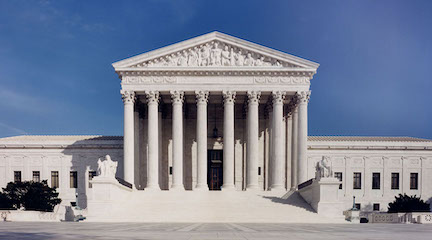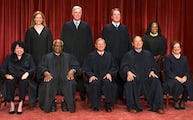The Public

Since 1981 and the advent of full television coverage of the appearance of
a Supreme Court nominee before the Senate Judiciary Committee, the public
has played an increasingly significant role
in the appointment process. The corresponding increase in the number and the
reach of advocacy groups engaged in the process has also served to bring
the nomination and confirmation process into the public forum. Controversy
can emerge only when significant opposition arises and significant opposition
requires a portion of the public sufficiently aroused that senators will take
note. The close vote confirming the appointment of Clarence Thomas in 1991
resulted in a number of senators facing repercussions in the 1992 election.
The Roberts nomination in 2005 is the first to experience the full effect
of the Internet age and advocacy groups have been created specifically to
activate public opinion in behalf of particular points of view. It will be
interesting to see what effect, if any, the Internet has on the process.
At a minimum, the opportunity for a citizen to become informed about the
nominee has never been greater.
Citizen's Guide to Participating in the Confirmation Process
Here are a few pointers about participating in the confirmation process,
given that the nomination process itself is fairly closed, unless you have
those close ties to the president.
- Withhold immediate judgment. The announcement of a nominee is followed
by instant statements of support by members of the president's party
and advocacy groups generally supportive of the president. If the
nominee is sufficiently high profile, you may also witness instant
opposition expressed as well. Resist either impulse. You can't know
whether the president made a good or bad choice from your particular
perspective until you familiarize yourself with the nominee's background,
record, and qualifications.
- Do your homework—part1. Read and listen to press accounts
that provide information and perspective about the nominee and the
nomination. Keep in mind that part of the significance of a nomination
is not only who the nominee is but who the departing justice is. Pay
attention to the potential impact of this nominee upon the Court itself
and evaluate whether that is an impact you would like to see.
- Do your homework—part2. Expand your attention to the Web sites
of advocacy groups. Look at competing perspectives. The table provided
on the Advocacy Groups page can get you
started. With advocacy groups, you will want to watch for the use
of catch phrases that have been co-opted by one side or another and
used as propaganda. See the table presented below.
- Determine where you stand on the nomination and decide whether you
want to take any action to express your views. In a controversial
nomination it may pay for everyone to get involved; the outcome may
be in doubt. In the absence of controversy, opponents of a nomination
need to try to raise the consciousness level of those who are potential
opponents. Proponents might be tempted to sit back and not worry,
but letting opponents seize the initiative can prove fatal. In 1987,
supporters of the Bork nomination failed to realize until it was too
late that the opponents of the nomination had gained the upper hand.
- Possible actions you might take are:
- Join with like-minded others by supporting an advocacy group that
effectively represents your views and determine what assistance you
might provide.
- Identify state and local opinion leaders who share your view and
let them know you support that view.
- Encourage your friends and like-minded acquaintances to pursue
points a and b.
- Letters to the editor of the local press can raise the consciousness
of others regarding the nomination. Consider crafting a well-reasoned
argument for your position.
- Communicate with the offices of certain senators. Often the state
and local offices are better targets at receiving mail and phone calls.
D.C. offices can be too congested, although there is nothing wrong with
adding your tic to the tally of calls for and against. Pay attention to
who the key senators are for any particular nomination—key votes
on the Senate Judiciary Committee and key votes in the Senate. In the
Roberts nomination we would be talking about Republicans who might not
support the nominations or Democrats who might support it.
- Stay informed. Often information does not come out until the Senate Judiciary
Committee hearings occur.
The Rhetoric of Judicial Selection
Politics is the art of persuasion and persuasion relies on rhetoric. The
names of advocacy groups themselves represent artful attempts at inclusiveness
that enhances credibility while in some instances even masking what the
group is truly about. Keep alert for
doublespeak
and informal
fallacies. There's a battle out there for your minds and the less critical
you are about what you read, the more susceptible you are to the arguments
of others.
What's in a name?
Two of our primary advocacy groups that attend to judicial selection use
the word “justice” in their names: Alliance for Justice
and the Committee for Justice. They are hardly allies. The Alliance
came about in 1979, organized by those who argue that “ . . . the
public's interest is best served when the policies of government result
from a dialogue involving not just the decision-makers but also those
whose lives are directly effected by such decisions, and when laws are
measured against fundamental human rights and civil liberties by fair
and independent courts.” The Committee was founded in 2002, bringing
together prominent supporters of the Bush Administration to “ .
. . to defend and promote constitutionalist judicial nominees to the federal
courts and educate the public on the importance of judges in American
life.”
It's legitimate for you to question the name of an organization. “What
do you mean by justice and in what sense are you promoting justice?”
is a question that is fair to put to these two organizations. To take
another pair, what is the “American way” promoted by People
for the American Way and what exactly does Progress for America
view as progress in America? You should be able to discern those answers
by reading about them on their Web pages. Make advocacy groups earn
your trust and that begins with their being straightforward about who
they are and what they hope to achieve.
Judicial wordplay
Watch for the use of the terms presented here and take care to decode
them by their context and source.
- Politics, political, politicize — “It is hard
to understand why your nomination would generate controversy. The
answer is found in one word, ... and that word is 'politics.'”
Senator Hatch's comment to nominee Robert Bork was politics at its
purest—accusing one's opponents of playing politics. You should
understand that all Supreme Court vacancies, nominations, and confirmation
processes are political. Accusing others of playing politics in this
process is simply part of the political game.
- Fairness—Everybody favors fairness—fair judges,
fair selection processes, and so on. But fairness is in the eyes of
the beholder. To the minority, currently the Democrats, denial of
the long-standing right to filibuster nominations is unfair. To the
majority, currently the Republicans, using a filibuster to prevent
an up or down vote on a nominee is unfair. Advocacy is the strong
suit of politicians and politicos; consistency is not. When Republicans
and Democrats swap their control of the Senate or of the White House,
they largely swap arguments as well. Indeed, a standard political
game is to catch a politician making a case contrary to what he or
she has stated at another time when circumstances differed.
- Strict constructionism—President Bush describes John
Roberts as one who “ . . . will strictly apply the Constitution
and laws, not legislate from the bench.” This is evocative of
the term “strict constructionism” as used by Richard Nixon,
resurrecting a phrase attributed to James Polk in his own search for
Supreme Court justices. Interestingly, Polk wanted justices who would
support the expansion of individual liberties promoted by Jacksonian
democracy while Nixon sought justices who would limit individual and
civil liberties decisions that characterized the Warren Court. In
reality, from Nixon to George W. Bush, their strict constructionist
rhetoric aside, Republican presidents have sought justices who will
actively support basic conservative values and perspectives.
- Judicial restraint and judicial activism— Akin to
strict constructionism, the plain meaning of judicial restraint is
a justice who has a restricted view of the role of the courts, exhibits
deference to the popular branches of government and earlier decisions
of the Court, limits interpretations of the Constitution to original
intent or meaning as much as possible, and decides cases on the most
narrow grounds available. Judicial activists would be on the opposite
end of one or more of these characteristics. In a clever political
move, conservatives were able to label the Warren Court as a court
of judicial activists and conflate activism with liberalism, while
simultaneously seeking out jurists who could largely be described
as conservative activists.
- Originalism—Sometimes referred to as constitutionalism
and used as if it had a single meaning, one can clearly distinguish
between the constructs of original intent and original meaning (akin
to textualism). Original intent seeks constitutional and legislative
interpretation in meanings ascribed to those responsible for creating
and approving the text. Original meaning and textualism refer to the
plain meaning of the text, relying less on the uncertainties and ambiguities
involved in trying to interpret intent. Both have difficulties. Original
intent raises issues of whose intent should be assessed and determining
what that intention was, not to mention whether their intention should
be privileged in that way. Original meaning does not deal well with
ambiguities, which constitute a major portion of those cases that
are accepted for consideration by the Supreme Court.
|


